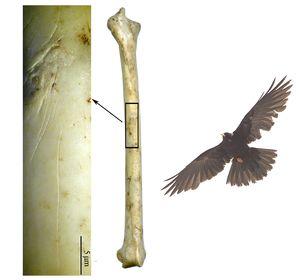Neanderthals Wore Feathers as Fashion Accessories
Rossella Lorenzi
Source - http://news.discovery.com/archaeology/neanderthals-feathers-accessories-110223.html
Neanderthals living in what is now Italy may have used feathers as fashion accessories, according to a study on 44,000-year-old bird bones.
While investigating Neanderthal remains in the Fumane Cave near Verona in northern Italy, paleoanthropologist Marco Peresani from the University of Ferrara and colleagues discovered 660 bird bones in layers that were dated to around 44,000 years ago.

Photo: Artist's reconstruction by Mauro Cutrona
Belonging to 22 species of birds, the remains included several wing bones which, according to the researchers, were deliberately cut to take the feathers off.
"Cut, peeling and scrape marks are observed exclusively on wings, indicating the intentional removal of large feathers," Peresani and colleagues wrote in the journal Proceedings of the National Academy of Sciences (PNAS).
The 22 species of birds included bearded lammergeiers, red-footed falcons, Eurasian black vultures, golden eagles, common wood pigeons, and Alpine choughs.
The colors of the plumage ranged from black, gray, blue-gray, and orange-slate gray.
"The Neanderthals from Fumane removed the remiges, which are the longest and more beautiful feathers," Peresani said.

Cut marks on the right ulna of Alpine chough (Pyrrocorax graculus) - Courtesy Marco Peresani
In line with previous research suggesting that Neanderthals may have worn brightly colored mollusc shells as jewelry, the researchers believe the feathers were used as ornaments.
Indeed, other explanations for the use of the feathers were ruled out: many of the birds from which the remiges were removed are poor food sources, and feathered arrows had not yet been invented.
"The species involved, the anatomical elements affected, and the unusual type and location of the human modifications indicate an activity linked to the symbolic sphere and the behavioral modernity of this European autochthonous population," the researchers wrote.
The finding adds to the debate over whether Neandertals were brutes or as sophisticated as Homo sapiens.
"This research might help dismiss an unfair prejudice and a creeping scientific racism. It shows that our extinct cousins had a particular concern about their physical appearance and their ethosocial identification, which is something that has long been considered a prerogative of the anatomically modern human," Peresani told Discovery News.